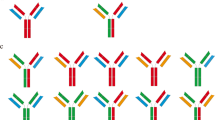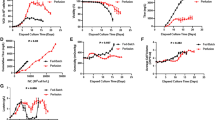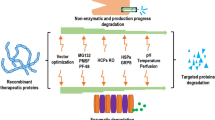Abstract
Aggregates in protein therapeutics like IgG monoclonal antibodies (mAb) are detrimental to product safety and efficacy. It has been reported that aggregates form in Chinese hamster ovary (CHO) cell lines expressing greater amount of heavy chain (HC) than light chain (LC). In this study, we observed that aggregates could form within the cells with excess HC and were partially secreted into the supernatant. The aggregates in the supernatant consisted of mainly HC and were partially dissociated under either reducing or denaturing conditions. Mutation of a predicted free cysteine on HC to prevent disulfide bonding did not reduce aggregation. Re-transfecting CHO cells with excess HC with more BiP, an important IgG molecular chaperone, partially reduced unwanted aggregates and fragments possibly by helping retain more incomplete products within the cell for either proper assembly or degradation. A second transfection of LC into CHO cells with excess HC to increase the LC expression to a level greater than the HC expression successfully removed all aggregates and fragments. mAb product aggregation in CHO cells with excess HC occur due to a combination of limited chaperones and LC:HC ratio. These results provide added insights to aggregate formation and would be useful for development of mAb cell lines with reduced aggregates.






Similar content being viewed by others
References
Mahler, H. C., Friess, W., Grauschopf, U., & Kiese, S. (2009). Protein aggregation: Pathways, induction factors and analysis. Journal of Pharmaceutical Sciences, 98, 2909–2934.
Cromwell, M. E., Hilario, E., & Jacobson, F. (2006). Protein aggregation and bioprocessing. AAPS Journal, 8, E572–E579.
Joubert, M. K., Luo, Q., Nashed-Samuel, Y., Wypych, J., & Narhi, L. O. (2011). Classification and characterization of therapeutic antibody aggregates. Journal of Biological Chemistry, 286, 25118–25133.
Phillips, J., Drumm, A., Harrison, P., Bird, P., Bhamra, K., Berrie, E., & Hale, G. (2001). Manufacture and quality control of CAMPATH-1 antibodies for clinical trials. Cytotherapy, 3, 233–242.
Yoo, S. M., & Ghosh, R. (2012). Simultaneous removal of leached protein-A and aggregates from monoclonal antibody using hydrophobic interaction membrane chromatography. Journal of Membrane Science, 390–391, 263–269.
Zhang, Y. B., Howitt, J., McCorkle, S., Lawrence, P., Springer, K., & Freimuth, P. (2004). Protein aggregation during overexpression limited by peptide extensions with large net negative charge. Protein Expression and Purification, 36, 207–216.
Schröder, M., Schäfer, R., & Friedl, P. (2002). Induction of protein aggregation in an early secretory compartment by elevation of expression level. Biotechnology and Bioengineering, 78, 131–140.
Feige, M. J., Hendershot, L. M., & Buchner, J. (2010). How antibodies fold. Trends in Biochemical Science, 35, 189–198.
Gonzalez, R., Andrews, B. A., & Asenjo, J. A. (2002). Kinetic model of BiP- and PDI-mediated protein folding and assembly. Journal of Theoretical Biology, 214, 529–537.
Lee, C. J., Seth, G., Tsukuda, J., & Hamilton, R. W. (2009). A clone screening method using mRNA levels to determine specific productivity and product quality for monoclonal antibodies. Biotechnology and Bioengineering, 102, 1107–1118.
Gomez, N., Subramanian, J., Ouyang, J., Nguyen, M. D., Hutchinson, M., Sharma, V. K., et al. (2012). Culture temperature modulates aggregation of recombinant antibody in CHO cells. Biotechnology and Bioengineering, 109, 125–136.
Ho, S. C. L., Koh, E. Y. C., van Beers, M., Mueller, M., Wan, C., Teo, G., et al. (2013). Control of IgG LC:HC ratio in stably transfected CHO cells and study of the impact on expression, aggregation, glycosylation and conformational stability. Journal of Biotechnology, 165, 157–166.
Borth, N., Mattanovich, D., Kunert, R., & Katinger, H. (2005). Effect of increased expression of protein disulfide isomerase and heavy chain binding protein on antibody secretion in a recombinant CHO cell line. Biotechnology Progress, 21, 106–111.
Mohan, C., & Lee, G. M. (2010). Effect of inducible co-overexpression of protein disulfide isomerase and endoplasmic reticulum oxidoreductase on the specific antibody productivity of recombinant Chinese hamster ovary cells. Biotechnology and Bioengineering, 107, 337–346.
Hayes, N. V. L., Smales, C. M., & Klappa, P. (2010). Protein disulfide isomerase does not control recombinant IgG4 productivity in mammalian cell lines. Biotechnology and Bioengineering, 105, 770–779.
Nishimiya, D. (2014). Proteins improving recombinant antibody production in mammalian cells. Applied Microbiology and Biotechnology, 98, 1031–1042.
Koh, E. Y. C., Ho, S. C. L., Mariati, Song, Z., Bi, X., Bardor, M., & Yang, Y. (2013). An internal ribosome entry site (IRES) mutant library for tuning expression level of multiple genes in mammalian cells. PLoS ONE, 8, e82100.
Livak, K. J., & Schmittgen, T. D. (2001). Analysis of relative gene expression data using real-time quantitative PCR and the 2(T)(−Delta Delta C) method. Methods, 25, 402–408.
Ho, S. C. L., Bardor, M., Feng, H., Mariati, Tong, Y. W., Song, Z., et al. (2012). IRES-mediated Tricistronic vectors for enhancing generation of high monoclonal antibody expressing CHO cell lines. Journal of Biotechnology, 157, 130–139.
Ho, S. C. L., Bardor, M., Li, B., Lee, J. J., Song, Z., Tong, Y. W., et al. (2013). Comparison of internal ribosome entry site (IRES) and Furin-2A (F2A) for monoclonal antibody expression level and quality in CHO cells. PLoS ONE, 8, e63247.
O’Callaghan, P. M., McLeod, J., Pybus, L. P., Lovelady, C. S., Wilkinson, S. J., Racher, A. J., et al. (2010). Cell line-specific control of recombinant monoclonal antibody production by CHO cells. Biotechnology and Bioengineering, 106, 938–951.
Liu, H., & May, K. (2012). Disulfide bond structures of IgG molecules: Structural variations, chemical modifications and possible impacts to stability and biological function. mAbs, 4, 17–23.
Elkabetz, Y., Argon, Y., & Bar-Nun, S. (2005). Cysteines in CH1 underlie retention of unassembled Ig heavy chains. Journal of Biological Chemistry, 280, 14402–14412.
Chennamsetty, N., Helk, B., Voynov, V., Kayser, V., & Trout, B. L. (2009). Aggregation-prone motifs in human immunoglobulin G. Journal of Molecular Biology, 391, 404–413.
Schröder, M., & Kaufman, R. J. (2005). ER stress and the unfolded protein response. Mutation Research—Fundamental and Molecular Mechanisms of Mutagenesis, 569, 29–63.
Lee, Y. K., Brewer, J. W., Hellman, R., & Hendershot, L. M. (1999). BiP and immunoglobulin light chain cooperate to control the folding of heavy chain and ensure the fidelity of immunoglobulin assembly. Molecular Biology of the Cell, 10, 2209–2219.
Vanhove, M., Usherwood, Y. K., & Hendershot, L. M. (2001). Unassembled Ig heavy chains do not cycle from BiP in vivo but require light chains to trigger their release. Immunity, 15, 105–114.
Hendershot, L., Bole, D., Köhler, G., & Kearney, J. F. (1987). Assembly and secretion of heavy chains that do not associate posttranslationally with immunoglobulin heavy chain-binding protein. The Journal of Cell Biology, 104, 761–767.
Ho, S. C. L., Bardor, M., Feng, H. T., Mariati, Tong, Y. W., Song, Z. W., et al. (2012). IRES-mediated Tricistronic vectors for enhancing generation of high monoclonal antibody expressing CHO cell lines. Journal of Biotechnology, 157, 130–139.
Koh, E. Y. C., Ho, S. C. L., Mariati, Song, Z. W., Bi, X. Z., Bardor, M., & Yang, Y. S. (2013). An internal ribosome entry site (IRES) mutant library for tuning expression level of multiple genes in mammalian cells. PLoS ONE, 8, e82100.
van Berkel, P. H. C., Gerritsen, J., Perdok, G., Valbjorn, J., Vink, T., van de Winkel, J. G. J., & Parren, P. W. H. I. (2009). N-linked glycosylation is an important parameter for optimal selection of cell lines producing biopharmaceutical human IgG. Biotechnology Progress, 25, 244–251.
Yang, Y. S., Mariati, Ho, S. C., & Yap, M. G. (2009). Mutated polyadenylation signals for controlling expression levels of multiple genes in mammalian cells. Biotechnology and Bioengineering, 102, 1152–1160.
Acknowledgments
This work was supported by the Biomedical Research Council/Science and Engineering Research Council of A*STAR (Agency for Science, Technology and Research), Singapore. The authors wish to thank Kong Meng, Hoi for aiding in purification and analytics. We also thank Phyllicia Toh for providing technical support during use of the HPLC for aggregate analysis.
Author information
Authors and Affiliations
Corresponding author
Rights and permissions
About this article
Cite this article
Ho, S.C.L., Wang, T., Song, Z. et al. IgG Aggregation Mechanism for CHO Cell Lines Expressing Excess Heavy Chains. Mol Biotechnol 57, 625–634 (2015). https://doi.org/10.1007/s12033-015-9852-7
Published:
Issue Date:
DOI: https://doi.org/10.1007/s12033-015-9852-7




